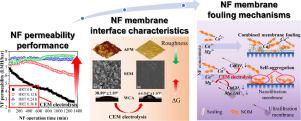Water Research ( IF 11.4 ) Pub Date : 2021-10-13 , DOI: 10.1016/j.watres.2021.117761 Jinlong Wang 1 , Heng Liang 1 , Xiaobin Tang 1 , Zhendong Gan 1 , Guibai Li 1

|
The combined fouling effect prevalent in the nanofiltration (NF) process severely limits its use. In this study, cation exchange membrane (CEM) electrolysis was performed to alleviate NF membrane fouling by controlling interface characteristics. The results revealed that CEM electrolysis (hydraulic retention time with 0.24 or 0.36 h) effectively improved NF membrane permeability by 201%–211% and achieved a stability of > 8 LMH/bar. The divalent cations were removed through CEM electrolysis, with a decrease in Ca2+ and Mg2+ by approximately 68.8% and 30.9%, respectively, which was related to scaling potential reduction. This softening function reduced the possibility of bridging of organics with divalent cations, which contributed to the lower molecular weight of organic matter (mainly humic substances) distributed in 1.4–23 kDa. The improved organic indicators of the NF membrane permeate quality implied that the membrane interface characteristics improved. The foulant layer on the NF membrane dominated humic substances, and biopolymers exhibited hydrophobic, smooth, and porous characteristics. The self-aggregation of foulants on the NF membrane surface stimulated the interface characteristics with high water permeability. Energy consumption confirmed the feasibility of CEM electrolysis on NF application. Thus, CEM electrolysis as a chemical-free approach that can be combined with NF and can provide guidance for NF membrane fouling in urban water treatment and water reclamation.
中文翻译:

无化学品方法控制纳滤膜的界面特性:CEM电解的可行性和机理洞察
纳滤 (NF) 工艺中普遍存在的综合污染效应严重限制了其使用。在这项研究中,进行阳离子交换膜 (CEM) 电解以通过控制界面特性来减轻 NF 膜污染。结果表明,CEM 电解(水力停留时间为 0.24 或 0.36 小时)有效地将 NF 膜渗透率提高了 201%–211%,并实现了 > 8 LMH/bar 的稳定性。通过 CEM 电解去除二价阳离子,Ca 2+和 Mg 2+ 减少分别降低了约 68.8% 和 30.9%,这与缩放潜力降低有关。这种软化功能降低了有机物与二价阳离子桥接的可能性,这导致分布在 1.4-23 kDa 的有机物(主要是腐殖质)的分子量较低。NF 膜渗透质量有机指标的改善意味着膜界面特性的改善。NF 膜上的污垢层主要是腐殖质,生物聚合物表现出疏水、光滑和多孔的特性。NF膜表面污染物的自聚集刺激了具有高透水性的界面特性。能耗证实了 CEM 电解在 NF 应用上的可行性。因此,











































 京公网安备 11010802027423号
京公网安备 11010802027423号